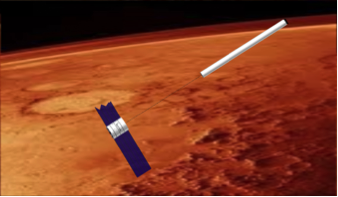The Hab shuttered slightly as the mild shock of the exploding bolts propelled the one and a half solar panels and the spent Falcon 9 booster away, each slowly tumbling end over end to eventually burn up in the planet’s atmosphere. There was no turning back at this point. Without the tethered counterweight of the booster, the crew would remain in zero gravity for the next twenty months, if they changed their minds now and really did want to head home.
But the crew were firmly committed to the next step in the landing sequence: firing the retro rockets that would slow the Hab’s orbit, allowing it to fall into the atmosphere of Mars and toward the small, un-named crater on the Avernus Colles. Lying on their backs and strapped into their seats on the floor and at the console, they could feel the push against their backs, the result of a twenty-seven second burst from the retros. At the end of the burn, Tom directed Carl to jettison the retro pack. Carl punched the button to fire the next set of exploding bolts, releasing the clamps. The retro pack was fired away and a large Kevlar bag instantly inflated. This action created a flexible bowl beneath them; a bowl that was two meters thick and four times the diameter of the Hab, engulfing it and doubling as a heat shield.
Referred to as the aero-brake, this bag/bowl would begin slowing the Hab’s descent, as soon as the atmosphere became thick enough to start providing some resistance. When that resistance becomes so great that the heat begins burning the bag away, it too will be jettisoned. At that time, parachutes will pop out of the Hab’s top and landing thrusters begin firing to further slow their speed of descent. The entire process, running in succession from firing the retro rockets to eventual touch down among the rolling hills, takes about seven minutes.

